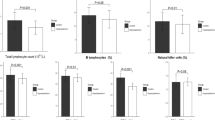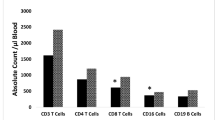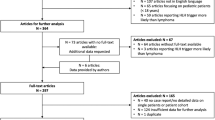Abstract
Summary: A study of peripheral blood lymphocyte populations in 27 children with Hodgkin's disease (HD) and 13 age-matched control subjects is presented. The absolute numbers and percentages of T and B lymphocytes identified by their surface marker characteristics were determined. In addition, in 13 HD children the percentages of T and B lymphocytes were estimated in the spleens removed at staging laparotomy. No differences were observed between the total peripheral blood lymphocyte counts of HD and control children, and we found no evidence of progressive lymphopenia with advancing stages of the disease. No decrease in the numbers of peripheral blood T lymphocytes was seen in this group of HD children. In contrast, the proportions and absolute numbers of B lymphocytes tended to be significantly lower in the children with HD than in the control subjects. In 9 of the 13 spleens studied high percentages of T lymphocytes were seen; low percentages of B lymphocytes were found in all spleens examined.
Speculation: The results are discussed in the light of the hypothesis that in HD an anomaly of the spleen environment is present at the early stages of the disease which results in sequestration of circulating T lymphocytes, and that this anomaly is closely related to the basic pathogenesis of the disease.
Similar content being viewed by others
Log in or create a free account to read this content
Gain free access to this article, as well as selected content from this journal and more on nature.com
or
Author information
Authors and Affiliations
Rights and permissions
About this article
Cite this article
Sousa, M., Tan, C., Siegal, F. et al. Immunologic Parameters in Childhood Hodgkin's Disease II. T and B Lymphocytes in the Peripheral Blood of Normal Children and in the Spleen and Peripheral Blood of Children with Hodgkin's Disease. Pediatr Res 12, 143–147 (1978). https://doi.org/10.1203/00006450-197802000-00016
Issue date:
DOI: https://doi.org/10.1203/00006450-197802000-00016



